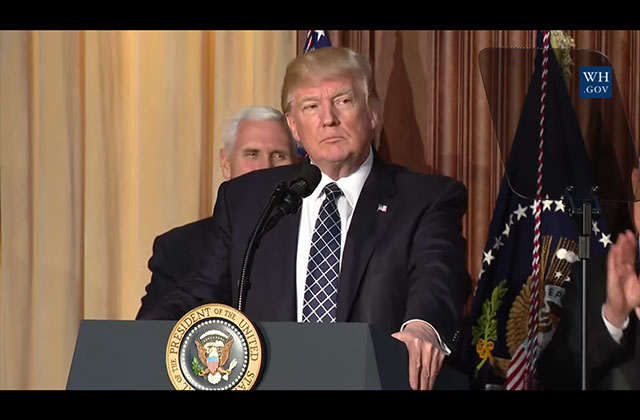Trump Signs Executive Order to Repeal Clean Power Plan

President Donald Trump signed the Energy Independence Executive Order today (March 28) at the EPA offices in Washington, D.C. He was joined by Vice President Mike Pence, Energy Secretary Rick Perry, Interior Secretary Ryan Zinke and EPA Administrator Scott Pruitt.
“We have a very, very impressive group here to celebrate the start of a new era in American energy production and job creation,” said Trump during the press conference. “The action I'm taking today will eliminate federal overreach, restore economic freedom and allow our companies and our workers to thrive, compete and succeed on a level playing field for the first time in a long time, fellas.”
While the president has been slowly repealing individual climate legislation put forth by predecessor President Barack Obama, this order marks the beginning of undoing major efforts Obama put forth like the Clean Power Plan (CPP), which laid out carbon reduction goals by restricting emissions at coal plants.
Obama signed the CPP into law in 2015, but industry opponents have kept it in litigation. It has yet to take effect, and this executive order is calling to revise and rewrite Obama’s landmark climate plan.
“Perhaps no single regulation threatens our miners, energy workers and companies more than this crushing attack on American industry,” the president said during his announcement.
This repeal means that the CPP will have to undergo the same laborious process it initially went through under Obama: public comment periods, time in the courts and (likely) more pushback—but this time from environmental groups. This process can take about a year (or possibly longer) as it goes down the same legal path as the original plan.
Trump has been clear since the beginning of his term that he would attempt to undo the CPP in hopes of reigniting the coal industry to “bring back jobs,” as he’s said in various occasions. “We will put our miners back to work,” Trump said during today's press conference.
But this promise may be easier said than done. While carbon regulations on the industry do make it virtually impossible to open a new coal power plant without carbon-capture technology, many plants already in existence have closed, in large part, due to competitive natural gas and renewable energy prices. Nonetheless, Trump’s order calls for changing these carbon standards.
“The problem with coal jobs has not been CO2 regulations, so this will probably not bring back coal jobs,” Robert W. Godby, an energy economist at the University of Wyoming, told The New York Times. “The problem has been that there has not been market demand for coal.”
Supporting his statement, there is a Kentucky-based plant that announced it will shut down by 2023. There’s also the Navajo Generating Station scheduled to close by the end of 2019. Both cite natural gas among reasons.
The president’s executive order did not mention the Paris Climate Agreement, but without the CPP, the U.S. is unlikely to meet its goals. The administration has confirmed to various outlets that it is still in discussion about the international agreement.
Here are other key moves the executive order does lay out:
- Deregulating methane, a greenhouse gas more effective at trapping heat than carbon that results from fracking and other oil and gas operations
- Decreasing the “social cost of carbon,” which places a per-ton price on the greenhouse gas based on its long-term environmental impacts. Obama’s administration decided on $36 per ton in 2015
- Allowing coal leasing on federal lands again. Obama placed a moratorium on this action in 2016 to review and update the program after receiving criticism from environmentalists that it was cheating taxpayers from financial gains
- Rolling back guidance on how agencies can factor climate change into environmental reviews required under the National Environmental Policy Act
- Undoing previous climate-focused executive orders from Obama like the Climate Action Plan and an order calling for climate resilency and preparedness
- Instructing all agencies to review their rules for any which hinder domestic energy production. They must send their findings within the next 180 days
So far, environmental groups, as well as the mayors of cities like Los Angeles, Seattle, Boston and Atlanta, have expressed their disappointment in the order. Some groups have already taken to D.C. in protest:
HAPPENING NOW: We are at the EPA in response to #TrumpsEO on the #CleanPowerPlan! Join us April 29th! #ClimateMarch pic.twitter.com/RocgUQzW0B
— People's Climate (@Peoples_Climate) March 28, 2017
Latinx leaders have also been vocal against the order in video interviews public relations firm Benitez Strategies shared with Colorlines.
“This is really worrisome, especially for the Latinx community, where we already see disparate impacts on our health, well-being and future,” said Adrianna Quintero, executive director of Voces Verdes, in Spanish. “We need our government to protect us and not the interests of the largest petroleum companies.”
“We are realizing that, many times, the water we drink is harmful,” said Ben Monterroso, executive director of Mi Familia Vota, in a separate Spanish-language video. “And I think that what President Trump is harming the most vulnerable with his executive orders.”
See more reactions in the tweets below.
#CleanPowerPlan not only an opportunity to curb #climatechange, but also decades of enviro health inequity. JOIN US: https://t.co/1sGc15OomR pic.twitter.com/ZBc3TPjtms
— WE ACT for EJ (@weact4ej) March 28, 2017
The choice between our climate and our economy is a false one. Retweet if you support America’s #CleanPowerPlan. pic.twitter.com/tvqw9oGrVx
— Climate Reality (@ClimateReality) March 27, 2017
"We’ll fight Trump in the courts, in the streets, & at the state and local level across America" -@bruneski https://t.co/b6dWwuddsI pic.twitter.com/p4cYhFE8qB
— Sierra Club (@SierraClub) March 28, 2017
Trump has launched an all-out assault on our environment. Show him we won’t stop fighting—join the #ClimateMarch: https://t.co/bOh2BCQ4f3 pic.twitter.com/TM8vCvjND6
— NRDC (@NRDC) March 28, 2017
Watch the full press conference in the video below.
(H/t The New York Times, Vox)
